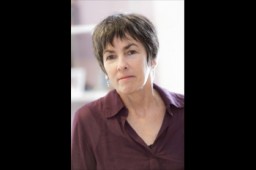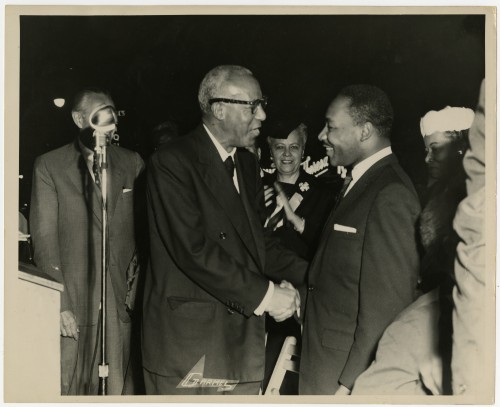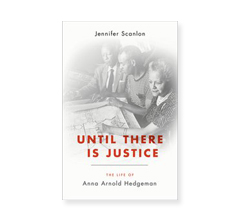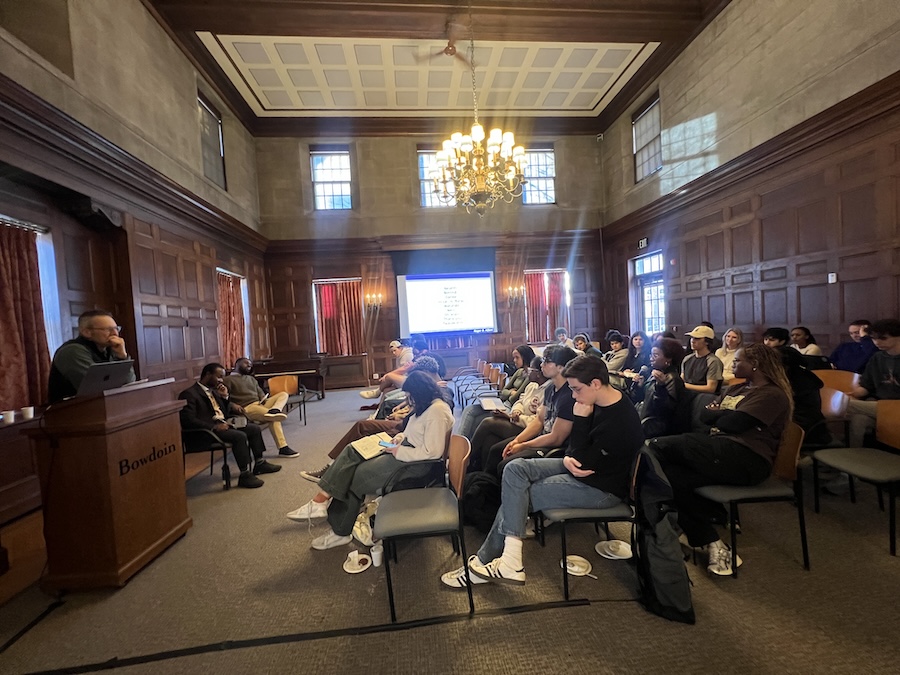Dean Scanlon's Latest Book Examines 'Unsung' Female Civil Rights Hero
By Tom Porter
Until There is Justice: The Life of Anna Arnold Hedgeman (Oxford University Press, January 2016), by Jennifer Scanlon, Dean of Academic Affairs, Bowdoin College
Scanlon’s book is the first biography of the African-American civil rights leader who helped organize the 1963 march on Washington, where Dr. Martin Luther King delivered his ‘I Have a Dream” speech.
A demanding feminist, devout Christian, and savvy grassroots civil rights organizer, Anna Arnold Hedgeman played a key role in more than half a century of social justice initiatives.
But until now, says Scanlon, she has received only a fraction of the attention she deserves. “The reason for that? “Well in large part, it’s because she was a woman.”
Why did you choose to write a biography of Anna Arnold Hedgeman? On the surface she seems quite different from your previous subject, Cosmopolitan editor Helen Gurley Brown.
For a long time I’ve been interested in women’s relationships to social movements, so it is a departure and it’s not. The Helen Gurley Brown biography focused in part on her relationship to feminism, as I argued that she was the working-class, urban, single women’s advocate, rather than the middle-class, suburban, married women’s advocate we hear so much more about (Betty Friedan). Her life showed some of the many dimensions of the development of a feminist consciousness.
In this book, I focus on the complicated relationship Anna Arnold Hedgeman had to both civil rights and feminism. She refused to move through her life with a single identity (woman, African American, Christian), so we gain a deeper understanding of the complexities of social movements as real people live them.
Well, the fact that so few people know who Hedgeman was says a lot about that relationship. As important as she was, Hedgeman was too often ignored by her contemporaries, even when they depended on her efforts, and since then she’s most often been ignored by historians chronicling the movement.
Hedgeman’s story fleshes out some of the complications of the civil rights movement as far as gender is concerned, but it also illustrates that Hedgeman and other black women of her time played formative roles as intellectuals in the development of civil rights, black theology, and feminism.
Just as one example, the simple but lasting narrative of feminism is that since its origins it has been a white, middle-class women’s movement. Yet Anna Arnold Hedgeman, as a founding member of the National Organization for Women (NOW), insured that questions of opportunity for poor women, questions of racial discrimination, and understandings of the ways in which race, class, and gender were interwoven, were part of the founding documents of the organization. From my perspective, she complicates any simple narrative about 20th century social movements.
Does it strike you as ironic that the civil rights movement, which was formed to combat one type of prejudice, was itself guilty of another type, gender discrimination?
African American women found a variety of ways to respond to the sexism of their day. As the only woman on the organizing committee for the 1963 March on Washington, Hedgeman pushed her colleagues to provide women a speaking voice during the march, but the men were unrelenting. She and other women voiced their protest in a number of ways, and finally a compromise was arrived at, allowing for a brief tribute to African American women during the proceedings. Hedgeman didn’t hesitate, then or after, to point out contradictions she witnessed, whether they resided with whites, with African American men, with Christians, with her nation. She was an advocate of a more just study of American history, including the study of women’s lives. Hedgeman noted, for example, that the anniversary of the March on Washington might well have been celebrated as Rosa Parks Day. The ironies, as you put it, frustrated her, but I wouldn’t say they surprised her.
What is Hedgeman’s legacy today?
At this moment, we would benefit tremendously by Hedgeman’s reasoned and demanding presence, but since she’s not with us we ought to take heed of her call for dignity and opportunity for all marginalized people.
Was Hedgeman saying it shouldn’t matter what color we are?
Hedgeman felt color should not matter but understood how deeply it did. As she put it, “I’m wasting half my life talking about race when I could be doing so many other things. This doesn’t allow me to be the full person that I am or to make the full contributions that I might.”
Still, she continued to wage a fight for civil rights because she saw no way around it.

How much of a challenge was it writing this biography?
It was truly a labor of love. I gained access to 200 boxes of unprocessed papers, at the National Afro-American Museum and Cultural Center in Ohio. With support from Bowdoin, and from the American Philosophical Society, I made many trips to Ohio to uncover the pieces of this complex and fascinating story.
What did you learn about Hedgeman that struck you the most?
During the Great Depression, facing a host of financial struggles, Hedgeman and her husband, noted tenor Merritt Hedgeman, pinned a “Declaration of Independence” to the curtain of their apartment in Harlem, signifying their determination to do the work they found most important, regardless of the risks involved. As I read through the countless papers in her archives, that act continued, to me, to seem emblematic of her life and work.

Brian J. Purnell, Associate Professor of Africana Studies and History, Bowdoin College
On Anna Arnold Hedgeman: “Her life of activism and service teaches us many lessons about the deep inequities that shape our nation. The protracted, frustrated struggles that have come with decades of involvement in multiple organizations and professional positions. She teaches us about the glimmers of progress that shine through the storm clouds of rejection and regression.”
Ellen Fitzpatrick, Professor of History, University of New Hampshire
On Margaret Chase Smith: “In 1964, Margaret Chase Smith, a moderate Republican senator from Maine, became the first woman to have her name placed in nomination for the presidency by a major political party. She was also the first woman to serve in both Houses of Congress, serving for nearly 33 years. John F. Kennedy described Smith as a ‘very formidable political figure.'” While Smith was a foreign policy hawk, Fitzpatrick says she was a liberal on many domestic issues.
On Shirley Chisholm: “In 1968 Shirley Chisholm, a progressive Democrat from New York City, became the first African American woman elected to Congress, overcoming barriers of race and gender. Four years later she too ran for the presidential nomination, and in that primary race, Chisholm got more votes than any woman candidate until Hillary Clinton in 2008.” Fitzpatrick says Chisholm’s rise to prominence was largely due to the political reforms brought about by the civil rights movement.
Alan Levy, Professor of History, Slippery Rock University, Pennsylvania
On Bella Abzug: “Who was Bella Abzug? She was a three-term Democratic congresswoman in the 1970s; she was an activist in any number of areas; she was above all things however, a very loud lady from the Bronx. It was said that Bella Abzug – aka “Battling Bella” – did not open doors for women, she busted them off their hinges. She was very different from Margaret Chase Smith, not least because she was vehemently against nuclear weapons.”



